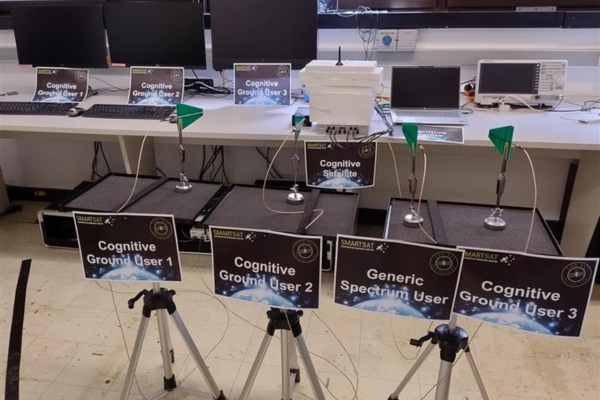As our world becomes increasingly crowded and saturated with diverse radio spectral signals, it is crucial to seize every opportunity to maximise communications outcomes for a broader range of users by sharing spectrum—while also prioritising critical communications in contested and congested environments.
As global demand for wireless communication grows, the radio frequency (RF) spectrum has become increasingly crowded and contested. This presents unprecedented challenges and threats, including interference, jamming, security vulnerabilities, and complex radio resource management issues. Addressing these challenges requires innovative solutions and strategic collaboration to ensure reliable, resilient communication, while also making the most of this precious resource.
Traditional satellite and space communication systems primarily rely on fixed hardware and static protocols. These systems are limited in their ability to adapt in real-time within challenged, contested, or congested environments. They lack the dynamic intelligence needed to detect, analyse, and respond to threats or spectrum congestion, reducing their resilience and effectiveness—particularly in defence applications. Moreover, in commercial settings, these systems are unable to maximise spectrum use when users hold exclusive licenses but are not actively using the bandwidth.
 The RMIT team performing a live demonstration of their CogSat work package.
The RMIT team performing a live demonstration of their CogSat work package.
This is where the Cognitive Satellite Radios (CogSat) project comes in—an initiative exploring how emerging technology can transform satellite communications by integrating sensing, learning, thinking, and adaptive functionalities through software-defined radios and agile algorithms. This enables real-time intelligence and operational flexibility in complex environments.
The CogSat project team has been exploring both defence and commercial use cases to demonstrate the technology’s potential. Two hardware testbeds, along with advanced software platforms, are showcasing cognitive technology and algorithms that validate its potential for dynamic, adaptive satellite systems—paving the way for more responsive and intelligent space-based communication networks.
CogSat improves the resilience and throughput of defence satellite systems in congested and adversarial environments through learned knowledge and advanced intelligence in both temporal and spatial domains—leveraging sensing and beamforming. Defence satellites can actively avoid interference and communicate more effectively in shared and contested spectral environments. Unlike traditional satellite communication systems, CogSat’s intelligent capabilities offer enhanced resilience against disruptions, increased operational efficiency, stronger security, and a lower cost per bit—making it a more robust and cost-effective solution for modern communication needs.
CogSat also brings advanced solutions to commercial communication challenges in the crowded RF environment—spanning terrestrial and satellite systems—including applications for 6G and beyond, such as Non-Terrestrial Networks (NTNs). By sensing, learning, predicting, and adapting, CogSat can help extract greater value from expensive satellite resources, leading to better outcomes.
 Hardware implementation at University of Technology Sydney of CogSat demonstration with multiple users operating efficiently in a congested and contested environment
Hardware implementation at University of Technology Sydney of CogSat demonstration with multiple users operating efficiently in a congested and contested environment
In early August, the four university partners involved in the project—Deakin University, Macquarie University, RMIT University, and the University of Technology Sydney—participated in hardware and software demonstrations held in Sydney and Melbourne.
These demonstrations showcased two different use cases. The first involved two independent satellite networks operating over geostationary and low Earth orbits (GEO and LEO, respectively). This scenario focused on how radio bandwidth usage can be maximised when a secondary network (e.g., LEO) opportunistically uses RF bandwidth not currently required by the primary (GEO) network. The second use case demonstrated increased resilience in contested and/or congested environments by mitigating the impact of unwanted users on a communications network.
Dr Zarko Krusevac, Future Satcom Technologies Lead at the Defence Science and Technology Group, said the project has strong potential to create impact and asymmetric advantage in future satellite communication systems for both civil and military applications.
“As a next step, we are planning to demonstrate the proof of technology to broader stakeholders in the telecommunications industry, including national and international defence agencies, satellite and terrestrial operators and service providers, and equipment and chip manufacturers,” he said.
“Recent unprecedented changes in the satellite industry have dramatically increased demand for spectrum and satellite-orbit usage. Civil use of the electromagnetic spectrum is now central to national and global economies and security. As outlined in the 2024 National Defence Strategy, Defence requires space capabilities that enhance intelligence, surveillance, and reconnaissance; provide resilient communications; and counter emerging space threats.
“The CogSat project is responding to these challenges by developing and implementing dynamic cognitive solutions that detect, analyse, access, share, and respond to congested and contested spectrum environments.”
The project team is now finalising technical work and documentation and planning future engagements with both defence and industry stakeholders to explore opportunities to continue advancing this important and impactful work.